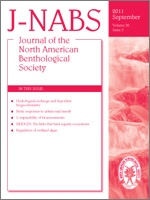Flood-pulsing is a key environmental factor that structures biotic communities in large-order river systems, but we focused our study on the effects of flood-pulsing in headwater systems. We used 10 mesocosm wetlands (10 m × 20 m) to test 2 treatments: a flood-pulse regimen in which natural flood events caused water levels to fluctuate and a static regimen in which water levels remained artificially stable. Abiotic characteristics, plants, and aquatic invertebrate communities were monitored from 2002 through 2005 in permanent pools, nonflooded banks in static wetlands, and intermittently flooded banks in flood-pulse wetlands. The flood-pulse treatment had minimal effects on environmental conditions of permanent pools, and submersed plant and aquatic invertebrate communities in permanent pools were similar in both treatments. This result suggested that resource subsidies from the floodplain to the pools were minimal. However, flood-pulsing caused observable changes to plant communities in the intermittently flooded zone (IFZ) above the permanently flooded pool. Overall plant diversity was higher in static wetlands, and % bare ground was higher in flood-pulse wetlands, results suggesting that the short, stochastic floods were a strong environmental stressor. In flood-pulse wetlands, the fluctuating water levels may have reduced the proportion of introduced, weedy, and upland plant taxa. Flood-pulse and static wetlands had distinctly different plant assemblage compositions, indicating that the abiotic stressors caused pronounced changes in the floodplain community. An indicator species analysis showed that taxa classified as obligate wetland plants were indicators in flood-pulse wetlands (e.g., Juncus canadensis, Ludwigia palustris, Dulichium arundinaceum, Eleocharis obtusa, Carex crinita, Carex lupulina, Carex vulpinoidea), but taxa classified as facultative wetland or upland plants were indicators of static wetlands (Cirsium arvense, Eupatoriadelphus maculatus, Plantago lanceolata, Bidens frondosus, Melilotus officinalis, Mentha arvensis, Daucus carota, Poa palustris). Many functional categories of plant species that were common in flood-pulse wetlands (e.g., obligate wetland plants, perennial, native and nonweedy species) are considered beneficial from a management perspective.
How to translate text using browser tools
13 September 2011
Responses of plants and invertebrate assemblages to water-level fluctuation in headwater wetlands
Maureen K Drinkard,
Mark W Kershner,
Angela Romito,
Julie Nieset,
Ferenc A de Szalay
ACCESS THE FULL ARTICLE
It is not available for individual sale.
This article is only available to subscribers.
It is not available for individual sale.
It is not available for individual sale.
Aquatic invertebrates
Flood-Pulse Concept
functional categories
hydrology
intermittently flooded zone
obligate wetland plants
riparian wetlands





